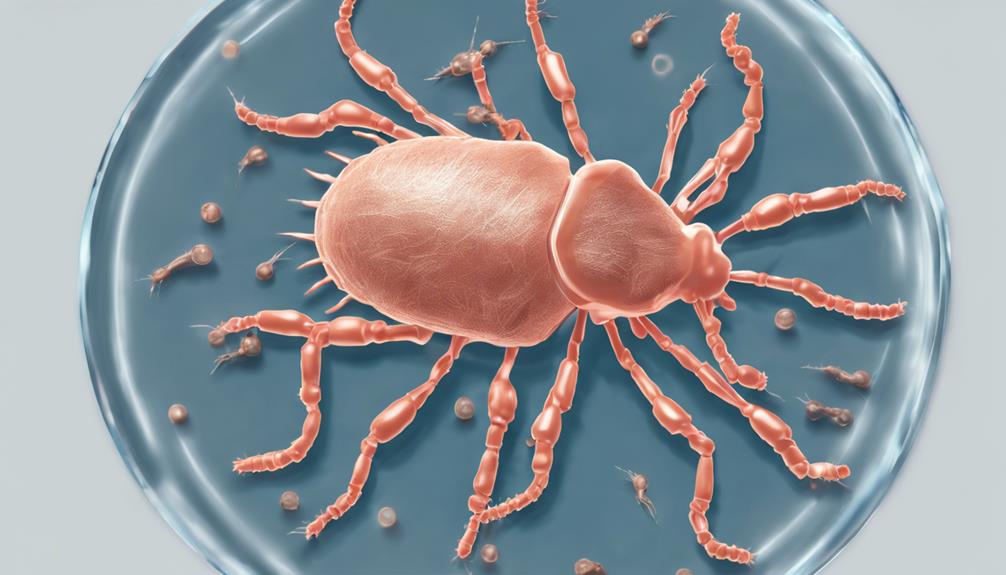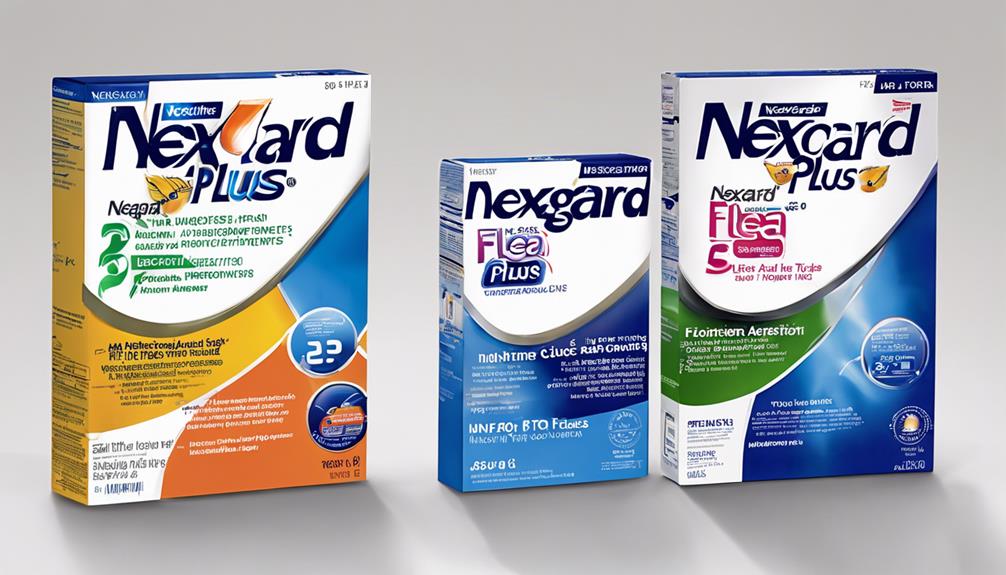Does Nexgard Kill Mites
Yes, Nexgard kills mites by disrupting their nervous system and stopping them from feeding on your pet. It prevents them from reproducing, ensuring continuous protection. Remember to administer Nexgard as directed for optimal results. If you require more information on Nexgard's efficacy against mites and potential side effects, keep exploring the details provided.
Key Takeaways
- Nexgard effectively kills mites by disrupting their nervous system.
- Studies demonstrate Nexgard's efficacy against various mite species in pets.
- Administering Nexgard as directed ensures continuous protection against mites.
- Regular use of Nexgard can help prevent mite infestations on your pet.
- Nexgard is a valuable option for controlling and eliminating mites in pets.
Understanding Mites and Their Risks
To understand the risks associated with mites, it's crucial to delve into their characteristics and potential dangers. Mites are tiny arthropods that belong to the class Arachnida, closely related to spiders and ticks. These minuscule creatures can be found in various environments, including soil, plants, animals, and even humans. Despite their small size, mites can pose significant health risks.
Some species of mites are known to cause skin irritations, allergic reactions, and even transmit diseases to both animals and humans. These risks make it essential to take preventive measures to control mite infestations.
Mites reproduce rapidly, leading to large populations in a short amount of time. Their ability to cause discomfort and health issues emphasizes the importance of addressing mite infestations promptly. Regular cleaning, vacuuming, and maintaining proper hygiene can help reduce the risk of mite-related problems.
Understanding the behavior and risks associated with mites is crucial in implementing effective strategies to mitigate their impact on health and well-being.
Mechanism of Action of Nexgard
Nexgard works by targeting and disrupting key physiological processes in parasites, effectively eliminating them from your pet's system. The active ingredient, afoxolaner, interferes with the parasites' nervous system by binding to specific receptors, leading to uncontrolled activity and eventual death.
This disruption prevents mites from feeding on your pet's blood and laying eggs, ultimately breaking the mite's life cycle. By administering Nexgard as directed by your veterinarian, you ensure that the medication reaches therapeutic levels in your pet's bloodstream, providing continuous protection against mites.
It's important to note that Nexgard is designed to specifically target parasites like mites while being safe for your pet. Understanding how Nexgard works to combat mites can give you peace of mind knowing that you're taking proactive steps to protect your furry companion from these harmful parasites.
Studies on Nexgards Efficacy Against Mites
Targeting mites specifically, research studies have explored Nexgard's efficacy in eliminating these parasites from pets. One study published in the Veterinary Parasitology journal demonstrated that afoxolaner, the active ingredient in Nexgard, effectively killed Demodex mites in dogs. Another study in Parasites & Vectors found that afoxolaner provided effective treatment against Sarcoptes scabiei mites in foxes. These findings suggest that Nexgard may be a valuable option for pet owners looking to control mite infestations.
Additionally, a study in the Journal of Veterinary Pharmacology and Therapeutics evaluated the efficacy of afoxolaner against Otodectes cynotis mites in cats. Results showed that Nexgard effectively eliminated these ear mites. These studies collectively indicate that Nexgard has shown promise in combating various types of mites that commonly affect pets. If your pet is suffering from a mite infestation, Nexgard could be a potential solution worth discussing with your veterinarian.
Potential Side Effects and Considerations
Considering the use of Nexgard for mite infestations in your pet, it's essential to be aware of potential side effects and important considerations. While Nexgard is generally well-tolerated, some pets may experience side effects such as vomiting, diarrhea, lethargy, or lack of appetite. In rare cases, more severe reactions like seizures or skin irritation can occur. It's crucial to monitor your pet after administering Nexgard and consult your veterinarian if any concerning symptoms arise.
Additionally, Nexgard isn't suitable for all pets, especially those with a history of seizures or neurologic disorders. It's important to inform your veterinarian about your pet's medical history and any medications they're currently taking before starting Nexgard. Pregnant, breeding, or lactating animals should also avoid Nexgard unless specifically recommended by a veterinarian.
Remember to follow the dosage instructions carefully and never give Nexgard to animals for which it isn't intended. If you have any concerns about using Nexgard for mite control in your pet, always seek professional advice from your veterinarian.
Recommendations for Mite Prevention and Treatment
To effectively prevent and treat mite infestations in your pet, prioritize regular veterinary check-ups and discussions about appropriate preventative measures. Your veterinarian can recommend the best preventive treatments for your pet based on their lifestyle and risk factors.
Maintaining a clean living environment for your pet, including regular bedding changes and cleaning of their living spaces, can help reduce the risk of mite infestations. Additionally, grooming your pet regularly can help you detect any signs of mites early on.
If your pet is diagnosed with mites, follow your veterinarian's treatment plan diligently. Treatment often involves medications that target the mites directly or soothe the symptoms caused by mite infestations. It's crucial to follow the prescribed treatment schedule and attend follow-up appointments to ensure that the mites are effectively eliminated.
Frequently Asked Questions
Can Nexgard Be Used to Treat Mites in Other Animals Besides Dogs?
You can use Nexgard for mite treatment in other animals besides dogs. It's effective against various types of mites. Always consult a vet for proper dosage and administration to ensure your pet's safety.
Are There Any Known Interactions Between Nexgard and Other Medications Commonly Used to Treat Mites?
When you consider interactions between Nexgard and other mite medications, always consult your vet. Mixing different treatments can have unexpected effects on your pet's health. Your vet will guide you in the right direction.
How Long Does It Typically Take for Nexgard to Start Killing Mites After Administration?
After administration, Nexgard typically starts killing mites within hours. It works quickly to eliminate these pests, providing relief for your pet. Keep an eye out for any signs of mite infestation, and consult your vet if needed.
Are There Any Specific Breeds of Dogs That May Be More Prone to Mite Infestations Than Others?
Certain breeds, like Spaniels and Terriers, may be more prone to mite infestations due to their coat type and skin characteristics. Regular grooming, vet check-ups, and preventative treatments can help manage mite issues effectively.
Is Nexgard Safe to Use in Pregnant or Nursing Dogs With Mite Infestations?
When dealing with pregnant or nursing dogs facing mite infestations, it's crucial to consult your vet before using Nexgard. Safety concerns for the mother and her puppies must be addressed properly to ensure their well-being.
Conclusion
In conclusion, Nexgard isn't specifically designed to kill mites, but it may help prevent infestations by targeting fleas and ticks.
It's important to consult with a veterinarian for proper mite prevention and treatment options.
Remember to always follow recommended dosages and guidelines when using Nexgard to ensure the safety and well-being of your pet.
Stay proactive in protecting your furry friend from potential mite risks.








